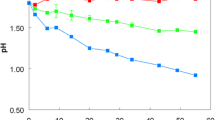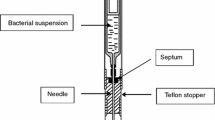Abstract
The substrate and products of the hydrogenlyase complex, formic acid, carbon dioxide, and molecular hydrogen, are co-operatively implicated in maintaining growth of E. coli under anaerobic conditions. Growth is observed in the presence of a combination of carbon dioxide + molecular hydrogen, or carbon dioxide + formic acid in the medium. The study shows that it is possible to culture E. coli under anaerobic conditions while sparging with nitrogen, without supplementing exogenous carbon dioxide, formic acid or molecular hydrogen. This condition occurs when the strain is allowed an appropriate induction period and is present at a sufficiently high cell density, since the cell density affects the rate of e.g. CO2 production. In a system sparged with nitrogen gas, the removal of CO2 due to this sparging must be balanced with a cell density dependent production rate of CO2. It is concluded that the “formic hydrogenlyase complex” should be considered as an integral part of the general maintenance of the anabolism of E. coli during anaerobic conditions on a mineral salts medium, as well as being a net producer of end products in E. coli metabolism.
Similar content being viewed by others
References
Swanson, H. D.: Ogg, J. E.: Carbon dioxide regulation of formate hydrogenlyase in Escherichia coli. Biochem. Biophys. Res. Comm. 36 (1969) 4: 567–575
Repaske, R.: Clayton, M. A.: Control of Escherichia coli growth by CO2. J. Bacteriol. 135 (1978) 1162–64
Hems, R.; Saez, G. T.: Equilibration of metabolic CO2 with performed CO2 and bicarbonate. FEBS letters 153 (1983) 2: 438–440
Fujita, N.: Izui, K.: Nishino, T.: Katsuki, H.: Reaction mechanism of Phosphoenolpyruvate Carboxylase. Bicarbonate-Dependent Dephosphorylation of Phosphoenol-α-ketobuturate, Biochemistry 23 (1984) 174–1779
Lacoursiere, A.: Thompson, B. G.; Kole, M. M.; Ward, D.; Gerson, D.F.: Effects of carbon dioxide concentration on anaerobic fermentation's of Escherichia coli. Appl. microbiol. Biotechnol. 23 (1986) 404–6
Hörnsten, E. G.: Carbon dioxide affects the growth rate of “oxygen limited” Escherichia coli at low concentrations of oxygen. Biotechnol. lett. 14 (1992) 3: 189–194
Clark, D. P.: The fermentation pathways of Escherichia coli. Microbiol. Rev. 63 (1989) 223–234
Visser, W.: Scheffers, A.W.; Batenburg-van der Vegte, W. H.; van Dijken, P.: Oxygen requirements of yeasts. Appl. Environ. Microbiol. 56 (1990) 12: 3785–92
Yegneswaran, P. K.; Gray, M.: Thompson, B. G.: Kinetics of CO2 Hydration in fermentors: pH and pressure effects. Biotechnol. Bioeng. 36 (1990) 92–96
Hörnsten, E. G.: On using H2 as parameter in studies of mixing. Bioproc. Eng. 7 (1992) 7: 287–290
Hörnsten, E. G.; Danielsson, B.; Elwing, H.; Lundström, I.: Sensorized on line determinations of molecular hydrogen in Escherichia coli fermentation's. Appl. Microbiol. Biotechnol. 24 (1986) 117–121
Hörnsten, E. G.; Nilsson, L. E.; Danielsson, B.: The production of molecular hydrogen by Escherichia coli during ampicillin-induced spheroplast formation. Appl. Microbiol. Biotechnol. 32 (1990) 455–60
Hörnsten, E. G.; Lundström, I.; Elwing, H.: Some biometrical applications of molecular hydrogen and ammonia determination by the use of metal-oxide-semiconductor devices. In, Bioinstrumentation; research, developments and applications. Ed. D. L. Wise, pp 47–91. Boston: Butterworths 1990
Gray, P. P.; Dunnill, P.; Lilly, M. D.: The effect of controlled feeding of glycerol on β-galactosidase production by Escherichia coli in batch culture. Biotechnol. Bioeng. 15 (1973) 1179–88
Ballantine, S. P.: Boxer, D. H.: Nickel containing hydrogenase isoenzymes from anaerobically grown Escherichia coli K12. J. Bacteriol. 163 (1985) 2: 454–459
Waugh, R.: Boxer, D. H.: Pleiotropic hydrogenase mutants of Escherichia coli K12: growth in the presence of nickel can restore hydrogenase activity. Biochimie 68 (1986) 157–166
Pinsent, J.: The need for Selenite and Molybdate in the formation of formic dehydrogenase by members of the Coli-aerogenes group of bacteria. J. Biochem. J. 57 (1954) 10–16
Gest, H.: Oxidation and evolution of molecular hydrogen by microorganisms. Bacteriol. rev. 18 (1954) 43–73
Gottschalk, G.: In: Bacterial Metabolism, Berlin: Springer-Verlag 1988
Sawers, R. G.; Ballantine, S. P.; Boxer, D. H.: Differential expression of hydrogenase isoenzymes in Escherichia coli K-12. Evidence for a third isoenzyme. J. Bacteriol. 164 (1985) 3: 1324–1331
Author information
Authors and Affiliations
Additional information
This work was supported by the Swedish National Board for Industrial and Technical Development. A. Askendahl is acknowledged for valuable assistance in the preparation of figures and P. Warkentin for language editing.
Rights and permissions
About this article
Cite this article
Hörnsten, E.G. On culturing Escherichia coli on a mineral salts medium during anaerobic conditions. Bioprocess Engineering 12, 157–162 (1995). https://doi.org/10.1007/BF00369595
Received:
Issue Date:
DOI: https://doi.org/10.1007/BF00369595




